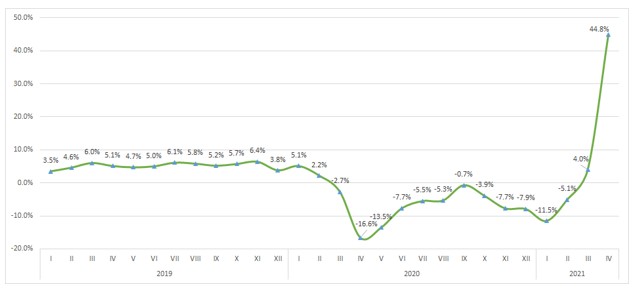Badri Japaridze: “When you had a catastrophic economic downturn and you measure the numbers from there whilst taking pride in this as growth, this is like throwing dust in everyone’s eyes.”
Verdict: FactCheck concludes that Badri Japaridze’s statement is MOSTLY FALSE.
Resume:
In April 2020, the economy decreased by 16.6% as a result of stringent pandemic-related restrictions. Therefore, it was expected that the economic growth rate would be in double digits under less restrictions in April 2021 as compared to the previous April and highlighting high economic growth in these circumstances would be manipulative. However, the 44.8% economic growth in April 2021 did exceed all reasonable expectations. However, there are still some unanswered questions in regard to the factors stipulating such a high growth.
The 44.8% economic growth in April 2021 implies that the economy increased by 20.7% as compared to April 2021. This means that the economic growth in April 2021 not only offsets the base effect of the 16.6% economic downturn in April 2020 but still constitutes a substantially high growth rate even without the drop. Therefore, Badri Japaridze’s statement is not true. Although, naturally, some portion of the 44.8% economic growth is because of the base effect. Mr Japaridze’s statement would have been relevant if the economic growth rate in April 2021 had stayed within the margins of 20-25% as was reasonably expected among the public.
Of note is that the spirit of Badri Japaridze’s statement is partially right when he decries “loud” statements as groundless since they are only based on one-month data. Under the current circumstances when Georgia’s economy is already small, an even smaller monthly figure (base) vis-à-vis the economy can be technically out of place from the big picture. This can happen by delaying certain activities that had to be done in the previous month or vice versa by doing something ahead of schedule. This is particularly true when general economic procedures and decisions remain unstable in light of ever-changing regulations and a higher degree of uncertainty (they are either delayed or enacted ahead of time).
Analysis
The leader of the Lelo for Georgia political party, Badri Japaridze, speaking about the 2021 economic growth data, stated: “When you had a catastrophic economic downturn and you measure the numbers from there whilst taking pride in this as growth, this is like throwing dust in everyone’s eyes.”
According to the preliminary assessment of the National Statistics Office of Georgia, the real gross domestic product (GDP) growth in April 2021 was 44.8% as compared to the same period of the previous year. At the same time, the average economic growth rate of the first four months of 2021 is 8.1%. In March 2021, the real GDP growth was 4.0% as compared to the same period of the previous year whilst average real economic decline in the first quarter was -4.2%.
Graph 1: Economic Growth in 2019-2021, Monthly Data

Source: National Statistics Office of Georgia
Naturally, some questions were raised among the public in regard to the April 2021 economic growth rate. To some extent, it was expected to have a high double-digit economic growth rate in April 2021 since the economy shrank by 16.6% in April 2020 owing to stringent restrictions. However, the 44.8% economic growth in April 2021 implies that the economy increased by 20.7% as compared to April 2021. This means that the economic growth in April 2021 not only offsets the base effect of the 16.6% economic downturn in April 2020 but constitutes a substantially high growth as compared to the general trend.
At the same, the GDP in March 2021 increased by 1.2% as compared to March 2019. There are some questions about this since no major pandemic-related restrictions were lifted in April 2021 as opposed to March and the stringency index remained at the same level.
According to the information of the National Statistics Office of Georgia, the following fields registered growth in April 2021 as compared to April 2020: the processing industry, construction, trade, transportation and warehousing, hotels and restaurants, financial and insurance business, real estate and professional, scientific and technical activities. The mining industry, however, showed a trend of decrease.








